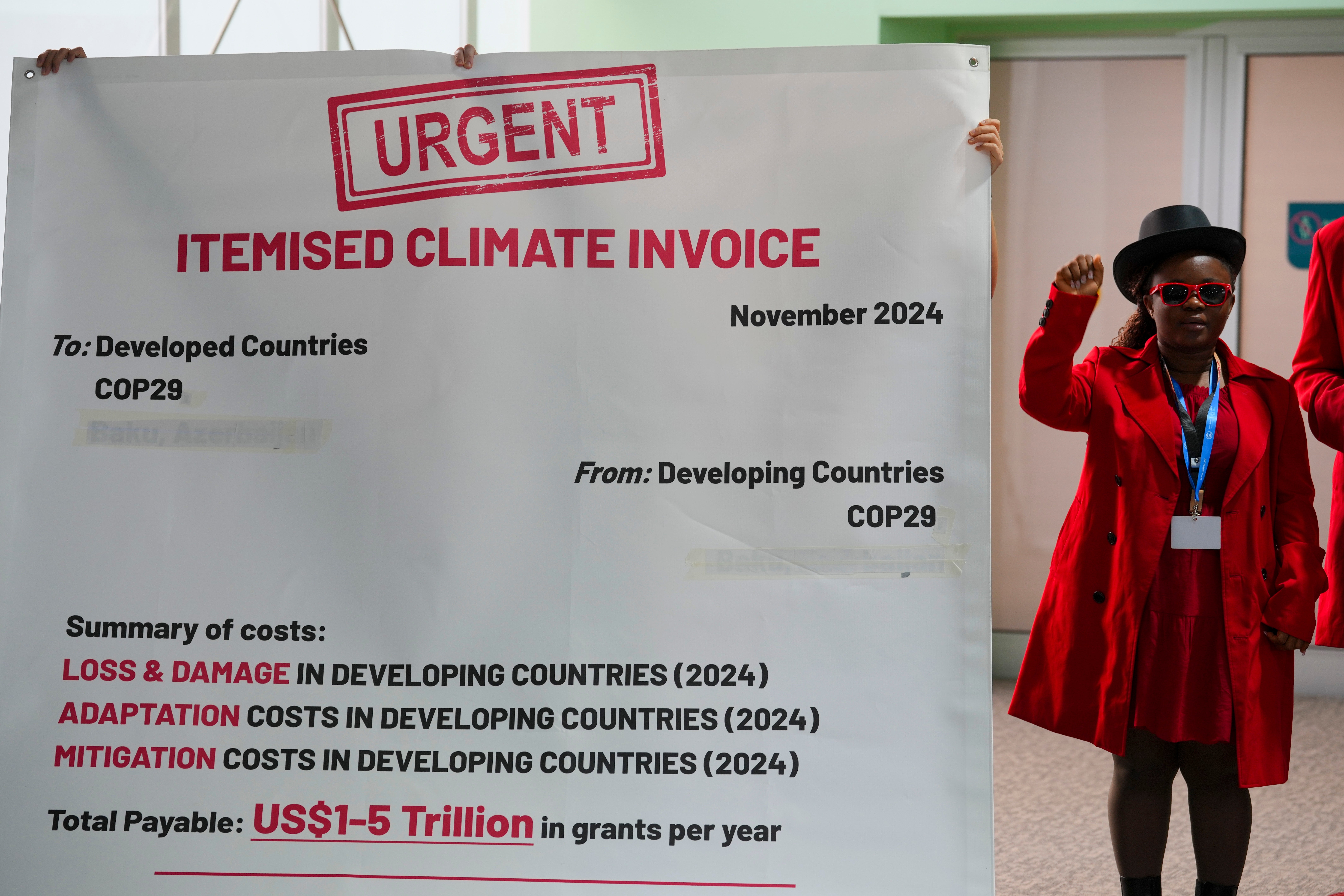Big money to respond to climate change is key to UN talks in Baku. How can nations raise it?
Big money to respond to climate change is key to the United Nations talks underway in Azerbaijan

Your support helps us to tell the story
From reproductive rights to climate change to Big Tech, The Independent is on the ground when the story is developing. Whether it's investigating the financials of Elon Musk's pro-Trump PAC or producing our latest documentary, 'The A Word', which shines a light on the American women fighting for reproductive rights, we know how important it is to parse out the facts from the messaging.
At such a critical moment in US history, we need reporters on the ground. Your donation allows us to keep sending journalists to speak to both sides of the story.
The Independent is trusted by Americans across the entire political spectrum. And unlike many other quality news outlets, we choose not to lock Americans out of our reporting and analysis with paywalls. We believe quality journalism should be available to everyone, paid for by those who can afford it.
Your support makes all the difference.Just as a simple lever can move heavy objects, rich nations are hoping another kind of leverage — the financial sort — can help them come up with the money that poorer nations need to cope with climate change.
It involves a complex package of grants, loans and private investment, and it's becoming the major currency at annual United Nations climate talks known as COP29.
But poor nations worry they’ll get the short end of the lever: not much money and plenty of debt.
Money is the key issue in Baku, where negotiators are working on a new amount for aid to help developing nations transition to clean energy, adapt to climate change and deal with weather disasters. It’ll replace the current goal of $100 billion annually — a goal set in 2009.
Climate cash could be in the form of loans, grants or private investment
Experts put the need closer to $1 trillion, while developing nations have said they'll need $1.3 trillion in climate finance. But negotiators are talking about different types of money as well as amounts.
Developed countries have aid budgets of $200 billion, said Avinash Persaud, climate adviser for the Inter-American Development Bank, and "they’re the ones going to be providing the finance in the system."
There's a big difference between $200 billion and $1.3 trillion. But that can be bridged with “the power of leverage," Persaud and others said.
When a country gives a multilateral development bank like his $1, it could be used with loans and private investment to get as much as $16 in spending for transitioning away from dirty energy, Persaud said. When it comes to spending to adapt to climate change, the bang for the buck, is a bit less, about $6 for every dollar, he said.
The World Bank president said all the multinational development banks could spend $125 billion on climate loans. Then those loans could be used as leverage for even more spending, several climate economics experts said.
“That's a big lever,” said Melanie Robinson, global climate economics and finance director at World Resources Institute.
But when it comes to compensating poor nations already damaged by climate change — such as Caribbean nations devastated by repeated hurricanes — leverage doesn't work because there's no investment and loans. That's where straight-out grants could help, Persaud said.
For developing nations, the talk of loans brings fear of debt
If climate finance comes mostly in the form of loans, except for the damage compensation, it means more debt for nations that are already drowning in it, said Michai Robertson, climate finance negotiator for the Alliance of Small Island States. And sometimes the leveraged or mobilized money doesn’t quite appear as promised, he said.
“All of these things are just nice ways of saying more debt,” Robertson said. “Are we here to address the climate crisis, which especially small developing states, least developed countries, have basically done nothing to contribute to it? The new goal cannot be a prescription of unsustainable debt.”
Robertson also scoffed at suggestions that leverage can turn $1 into $7 or even $16, saying that for small island nations, it often turns out to be more like a whopping $1.75.
His organization argues that most of the $1.3 trillion it seeks should be in grants and very low-interest and long-term loans that are easier to pay back. Only about $400 billion should be in leveraged loans, Robertson said.
Another method for funding climate finance could be an international tax. That could be on shipping, aviation or billionaires, experts, such as Robertson, suggested.
That would be politically difficult, but “the reality is that the world cannot tax up to $1 trillion of the taxpayers to make this happen, which is why we have to think about development finance and climate finance,” said United Nations Environment Programme Director Inger Andersen suggested.
Leverage from loans “will be a critical part of the solution,” Andersen said. But so must grants and so must debt relief, she added.
“Many countries are drowning in debt,” Andersen said. It's going to be a tough call for finance and climate ministers, she said.
“We have to see the courage of ministers to find a way that we can get to the right place,” Andersen said. “The reality is that climate change is happening right now. All countries are impacted. Nobody is immune to this. And the bill is just escalating more and more. And that is irrespective where you live on this beautiful planet of ours.”
___
Associated Press reporter Sibi Arasu contributed.
___
The Associated Press’ climate and environmental coverage receives financial support from multiple private foundations. AP is solely responsible for all content. Find AP’s standards for working with philanthropies, a list of supporters and funded coverage areas at AP.org.